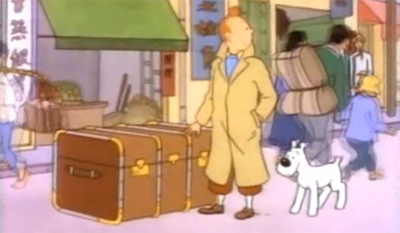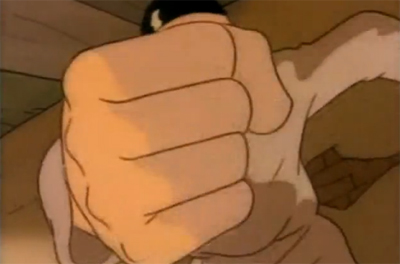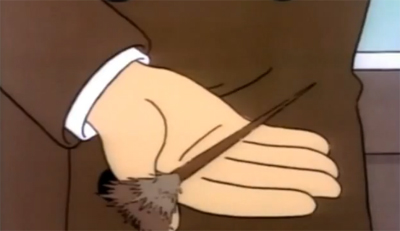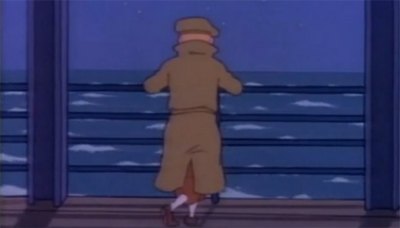To celebrate the release of The Adventures of Tintin: The Secret of the Unicorn in the United States later this month, I’ll be taking a look at some of nineties animated television show. Check back daily!
Note: This is our review of the animated episode, check out our review of the book here.
While I think that the early run of stories from Cigars of the Pharaoh were among Hergé’s most impressively pulpy output, populated with opium traders and sinister conspiracies seemingly spanning the globe, I do tend to have rather eclectic taste. For example, I am quite partial to The Black Island and The Shooting Star, two of the oft-malign chapters in The Adventures of Tintin. Similarly, I’ve found myself slightly underwhelmed by widely-praised instalments like The Secret of the Unicorn or The Blue Lotus. It’s not that I think they’re bad (far from it), merely that I feel they aren’t as good. Still, the animated adaptation of Tintin in America managed to construct an engaging little adventure from a disjointed story, so I wonder how this episode will handle its source material?
There’s a lot to like about The Blue Lotus. I’ve admitted as much in my review of Hergé’s story. It has a fantastic pulpy vibe to it, helped by the exotic setting, the involvement of the opium ring and even the presence of the Blue Lotus itself – “a private club in Shang-hai.” It perfectly replicates that sort of seedy retro feeling that Spielberg and Lucas were trying to capture in their Indiana Jones movies. The show does a nice job emulating that sort of vibe, and particular credit must be given to the soundtrack.
Composers Ray Parker and Tom Szczesniak do an excellent job building up an atmosphere – while it is occasionally a bit much, the pair do an excellent job creating a sense of sleazy melodrama around the boyish reporter’s explorations of a foreign underworld, with some piano work lifted almost directly out of a noir film. The entire series sounds a lot classier than your average cartoon, which is really something that stands to it.
The direction is also superb. On top of mirroring the art style, the cartoon has to translate Hergé’s panels into a coherent narrative. They have some great material to work with, but it can be hard to remain faithful and offer an entertaining television show. I think the show manages, by and large. It’s wonderfully faithful to Hergé’s style, but it knows how to produce broadcast drama. We get nice touches like a close-up on a blade, for example, to build tension, exploiting the additional time and space that a television show has. The director knows that it isn’t just his job to translate the story to the screen, but also to produce a piece of television that is as entertaining to watch as Hergé’s book was to read.
And that feel is really the best thing going for the adaptation – but it carries it a long way. This is the first time I really feel that something has been lost in translation, though. While the animated episode retains the core details of Hergé’s plot, and perhaps its soul (captured in interactions between Tintin and the young Chang), there are several aspects missing. The political subtext is almost completely removed from the story. Hergé’s adventure was set against the backdrop of the Japanese invasion of mainland China, and the failure of the League of Nations to intervene in any meaningful way. Here all we get is a reference to “the occupation”, and that’s about it. It’s a shame, because that broader context added a lot to Hergé’s stories, and I wonder how much we’ll lose for later adventures.
From a storytelling point of view, it’s also disappointing that we lose Gibbons, the racist foreigner. Of course, Gibbons’ abuse of the natives (and Tintin’s forceful objection to it) were undoubtedly intended to contrast with the colonial subtext of Tintin in the Congo, but it’s a powerful moment even outside of that context. It helps the reader get past some of the more awkward depictions of race that Hergé uses in his comic book, illustrating that the author’s heart seemed to be in the right place even if he was still making a few insensitive decisions. Without that sequence, and without the defense of being “a product of its time”, the animated episode’s depiction of the Japanese is quite unpleasant.
While all the native characters in the adventure seem to speak with the stereotypical Oriental accent we all know from pop culture, the episode retains the disinction between Hergé’s Chinese and Japanese characters. Researched and drawn with care, Hergé’s Chinese characters look like normal human beings, with all the proper proportions – a marked improvement over how the Belgian comic illustrated the African population in Tintin in the Congo.
However, all of his Japanese characters are portrayed as racist stereotypes, with buck teeth that seem to prevent them from even articulating properly. The sinister Mitsuhirato even has a nose like a pig’s snout. For an author trying to be more tolerant of other cultures, The Blue Lotus doesn’t make for the best defense of Hergé. While I’m not a fan of historical revisionism and writing racist or offensive texts out of history, I do think we need to be careful when presenting that to a younger audience that can’t discern problems the dissonance between the original time period and today. While I support, for example, the inclusion of offensive material in the archive collections of Looney Tunes (a series aimed at adults), rather than simply pretending it never happened, this is a series that has a primary audience composed of children.
When a photographer offers to take a picture of Tintin and Chang, the young boy protests, “Be careful, he’s not Chinese!” Of course, being a Japanese individual during a military occupation of China does single one out for suspicion, he could honestly be a photographer or a settled citizen. It might have been more appropriate for Chang to observe he could be “a spy” or “an agent”, rather than just being worth of suspicion because he doesn’t come from the country.
It’s a shame, because the scenes between Chang and Tintin work really well, and it’s nice seeing this and knowing that their relationship will be a key part of Tintin’s future. It’s also touching because it reflects the real life friendship that developed between Hergé and the young Chinese student who assisted him in writing the story. While there’s a lot of objectionable material in Hergé’s earlier stories, I do feel like the author is a product of his time, and that there are conscious attempts to overcome his own institutionalised prejudice.
Colin O’Meara continues to irritate as Tintin. His voice seems almost too mature and cynical for the boy reporter. “Maybe I should take a photograph of you with your own camera,” he warns a photographer who tried to assassinate him with a gun in a camera lens. It almost feels like “gritty” Tintin. Of course, the reporter has been through a lot, and has seen a lot of darkness, but I think there’s an enthusiasm in his character that O’Meara’s portrayal sorely lacks. It’s a shame, because the rest of the tone is remarkably good.
The Blue Lotus is another solid entry in the cartoon series, even if it does have a few glaring flaws stemming from what it chose to lift directly from the source material, and what it left behind.
Filed under: Television | Tagged: Adventures of Tintin, Black Island, blue lotus, China, Colin O'Meara, Hergé, japan, Orient, The Adventures of Tintin: Secret of the Unicorn, the adventures of tintin: the blue lotus, the blue lotus, tintin, tintin in america |


























Leave a comment